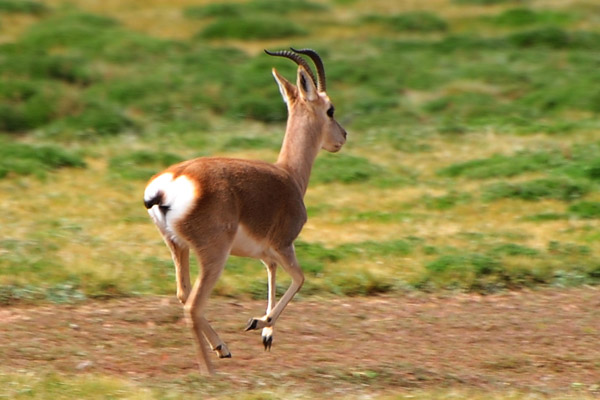TIBETAN GAZELLE
Procapra picticaudata
Physical Description
The Tibetan Gazelle is endemic to the Tibetan Plateau. The Gazelle has a sandy-brown to greyish-brown coat that is greyer in the summer than in the winter. The fronts of the Tibetan Gazelle’s slender legs are light grey. The inside of the Gazelle’s legs, the Gazelle’s belly, and the Gazelle’s large, heart-shaped rump patch are white. A light, rust-coloured border surrounds the rump patch. The Tibetan Gazelle’s hairs are erectible, and conspicuously fan out when the Gazelle is alarmed, such as when the Gazelle is fleeing from a predator.
The Tibetan Gazelle has a short black-tipped tail that measures approximately 5 to 10 centimetres (2 to 4 inches) long. Male gazelles have thin, ridged horns that measure an average of 28.9 centimetres (11.4 inches) in length. These horns curve up, backwards, and up again, the tips often bending in slightly.
The Tibetan Gazelle’s body is compact, measuring about 95 to 105 centimetres (3.1 to 3.4 feet) in length. The Gazelle stands about 60 to 65 centimetres (2 to 2.1 feet) high at the shoulder and weighs about 25 to 35 kilograms (55 to 77 pounds).
Habitat
The Tibetan Gazelle inhabits open landscapes, including plains, hills, and mountains. In the mountains, the Gazelle is found both in valleys and on high ridges. The Tibetan Gazelle avoids arid areas where few of the small forbs (non-grass herbs) that form an important part of the Gazelle’s diet grow.
Most Tibetan gazelles occur in Tibet, but small numbers may also be found in Ladakh and Northern Sikkim. Within Tibet, the Gazelle population in concentrated in the Chang Tang in northern Tibet.
Eating Habits
The Tibetan Gazelle predominantly eats forbs, shrubs, and seeds. The Gazelle has a high metabolism, due to its small size, so it requires the most nutritious forage available.
Behaviour and Reproduction
Most Tibetan Gazelle males, both yearling and adult, remain separate from female gazelles between May and December. A few of the males are solitary, but most live in small herds of five to ten. Sometimes several herds of gazelles are found close to each other. Female gazelles are more likely than the males to be dispersed, especially during the birth season.
The Tibetan Gazelle’s rut takes place from January to February. The Gazelle’s gestation period lasts 5.5 to six months. Most births occur between mid-July and early August. Each mother gives birth to a single young, weighing about 3 kilograms (7 pounds). Newborn gazelles hide for at least two weeks after birth, while they are gaining strength.
Present Status
The Tibetan Gazelle was categorized as Least Concern in the 2003 IUCN Red List of Threatened Animals. The Tibetan Gazelle is under second class protection in China and is included in Schedule I, Part I of the Indian Wild Life (Protection) Act of 1972. According to noted zoologist George Schaller, there may be as many as 100,000 Tibetan gazelles on the Tibetan Plateau.
Threats to Survival
The Tibetan Gazelle has been and continues to be widely hunted, especially for food. As Rawling noted, in the year 1905: “[the Gazelle’s] flesh is delicious.” The encroachment of livestock upon much of the Tibetan Gazelle’s pasture has also had a detrimental effect on the Gazelle’s numbers.
References
Mallon, D.P., 2003: Procapra picticaudata, In: IUCN 2003, 2003 IUCN Red List of Threatened Species, http://www.redlist.org, Sept 2004.
Schaller, George, B., 1998: Wildlife of the Tibetan Steppe, The University of Chicago Press, London.
Zeitschriftenverlag, Paul Parey, 2003: JAGEN WELTWEIT: Tibetgazelle Procapra picticaudata, http://www.jww.de/artikelbeitrag/
artikelbeitrag_13078.html, Aug 2004.
By: Environment and Development Desk, DIIR, CTA.



comment 0